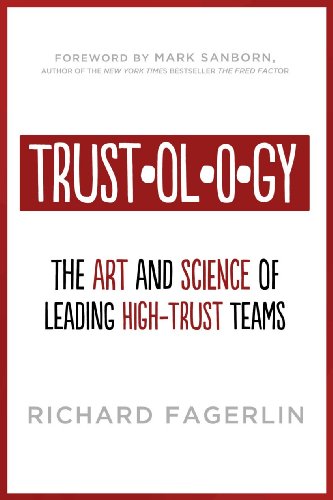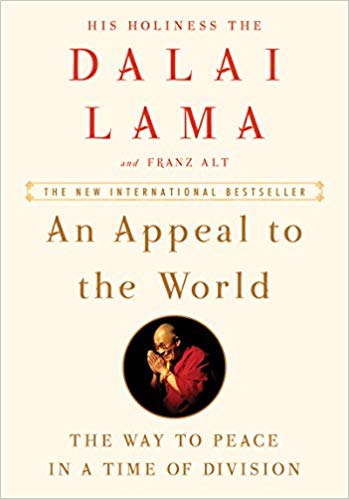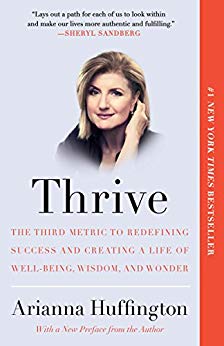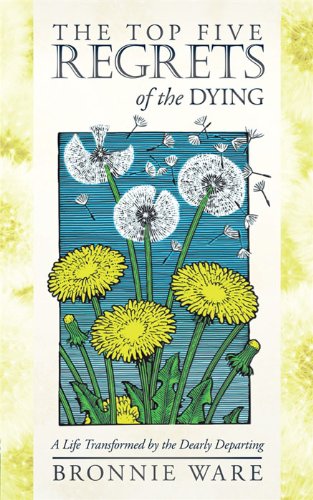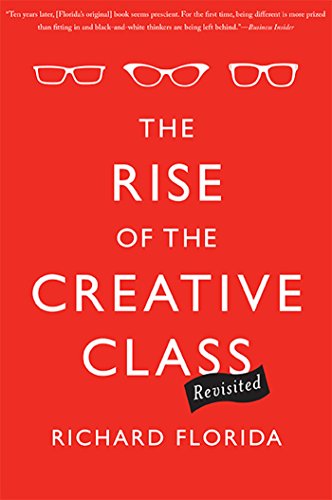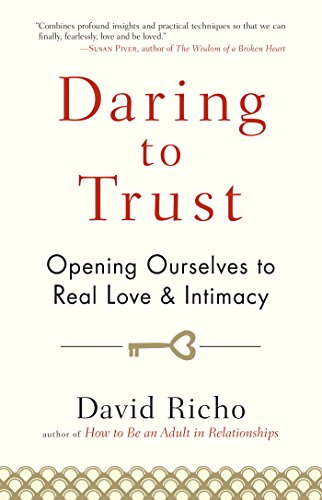
Book Review-Daring to Trust: Opening Ourselves to Real Love and Intimacy
Trust isn’t earned. Trust is given. Trust is us daring to be vulnerable so that we can enrich our lives and the lives of others. David Richo explores trust and its necessity in Daring to Trust: Opening Ourselves to Real Love and Intimacy. I’m familiar with Richo’s work through How to Be an Adult in Relationships – a book that I still heartily recommend. (Occasionally, the title gets me in trouble with folks, but it’s worth it if they read it.) He definitely has a deep understanding of human nature and what it takes to help us find our own path to healthy happiness.
I’ve also got a long history with trust. I just recently revisited an old post with Trust => Vulnerability => Intimacy, Revisited. The original post and the revision tie together the work of numerous authors to explain how trust leads to safety, which leads to vulnerability and, ultimately, intimacy. Richo connects trust to intimacy and our need to be connected to one another, so I resonated with the points he was making about our need for trust and how it moves us forward.
Time to Trust
Richo says, “Trust happens in the present and connects past experience with future probability.” In one sentence, he explains how trust is a bridge across time. It’s how we gather up our past experiences and use them in the present to make a bet for a better future for ourselves and others. Trust is a decision to take a risk that someone will betray us, because, if they do not, the rewards are so much greater.
Our past experiences greatly influence our ability to trust ourselves and, ultimately, others.
Learning Trust
We learn to trust just like everything else in life. Our first teaching comes from our parents and their ability to provide for our needs. We arrive on the planet totally dependent upon our parents for their support. We need clothing to keep us warm, food to allow us to grow, grooming to keep us clean, and protection from the many evils that lurk behind every corner. It’s during these early formative times that we begin to develop a sense for how the universe operates. Through our parents’ actions, we extrapolate about how the world at large works.
If parents are attentive to our needs, we believe that the universe wants good things for us. If we’re neglected or abused, it becomes hard to trust in the goodness of the universe. Our focus will be on survival and how we must protect ourselves, since no one else seems to be willing – or able – to do it.
Mary Ainsworth observed the way parents and children interacted and came up with three basic attachment patterns. The patterns she observed are:
- Secure – The child is comfortable whether with or away from their parents. As adults, they’re self-confident and appropriately independent.
- Anxious-avoidant – These children need constant affirmation and support from those around them. As adults, they’re demanding of their partners and peers.
- Anxious-ambivalent – As children, they’re compulsively independent. As adults, they may become victims.
Ainsworth discovered that parents who were attuned to their child’s needs – but not enmeshed with the child’s feelings – produced children whom she would describe as secure. Others have estimated that only 50-60% of adults are securely attached.
Trusting Ourselves
Some of us won the parental lottery. Our parents gave us a belief that the world was good and helpful. Our worldviews are shaped by opportunity, relative safety, and trust. This worldview often translates into our capacity to trust ourselves.
We see and celebrate our successes realizing that we can do anything we set our minds to. We’re not afraid of hard work, and we’ve seen many successes as a result. (See Peak and Mindset for more about the role of hard work.) The successes and our recognition of them creates an experience that leads us towards trusting ourselves.
Others aren’t as lucky. Their parents didn’t respond to them well, and they’ve developed a mistrust for the universe. The result is someone who is closed down. They don’t take risks, because they expect something bad will happen. And because they’ve taken few, if any, risks, it’s hard to find good things they’ve accomplished to celebrate. The net effect of this is a low degree of trust in oneself, because there is little or no experience to build that trust from.
The everyday slings and arrows that we must accept overwhelm the few things that could drive trust in ourselves. We forget a commitment. We fail on our New Year’s Resolution. All of that weighs on us and our ability to trust ourselves.
Trusting Others
It doesn’t take a specific betrayal to resist trusting others, though it certainly doesn’t help. Trusting others may be the hardest and most necessary thing that any human can do. Gone are the days when a person could stand alone. Those who think they’re independent now don’t know how to kill and prepare their own food, create electricity, build homes, purify water, or any of the thousands of things that we rely upon for our safe living. If we know how to do one or two of these things, that’s great. However, the reality of today’s modern living is that we don’t have any idea how to really survive on our own.
While our reliance on others is a matter of fact, our decision to trust others isn’t necessarily a forgone conclusion. We don’t have to trust others. We can decide that vaccines are evil and should be avoided. We don’t have to trust our doctor or the mountain of evidence that says vaccines have few harmful side effects and dramatically improve resistance to viruses by making our own immune system more capable of fighting it. This would, of course, be a bad decision, but we have the freedom to make it.
Love
Once, it may have been the only emotional force that showed us we were truly alive was fear. However, love has crept in as another way for our emotions to show us we’re alive. Certainly, when we’re in love, we often feel it with a mix of fear. In the initial stages, we are concerned the other person may not love us back. As love becomes more mature, we may fear we’ll lose our love for the other person, or they’ll lose their love for us.
From an evolutionary perspective, love coming after fear makes sense. We needed fear to allow us to avoid things that would be harmful to us. We discovered the first kind of love – infatuation or sexual love – to reproduce. The kind of love Richo’s talking about, a sustained commitment between a male and female, came later. It came, evolutionary biologists believe, when it became necessary for two parents to help with the rearing of children, as has certainly been the case for human development. Evolution taught us that we needed to have a commitment to one another to support our children.
When evolution needs something to happen for us to survive as a species, it has at its disposal powerful neurochemicals that can truly make us feel alive. Sometimes, that’s enough to commit to years of child-rearing – and sometimes it is not.
Performance-Based Love
When we speak of “love” in English, we have to detangle several different kinds of love. C.S. Lewis tries to do this in his book The Four Loves. Our global love for all is what the Greeks called agape. Our love of our brother was known as philos. Our sexual urges were known as eros. These are great, but none of them are really what we mean by the kind of committed love that Richo’s talking about.
Making things even more complicated is what some call “performance-based love,” which isn’t love at all. In fact, Richo acknowledges that our brain doesn’t even process it as love. Performance-based love says that I’ll love you as long as you’re performing. If I feel like you’re making me look better or enhancing my reputation, I’ll be “in love” with you. Of course, love is a choice, a decision, a commitment, so performance-based love isn’t love at all. (See Love, Acceptance, and Forgiveness for more on love as a commitment.)
Reality
The Buddha said that everything is impermanent. It is a central tenet of Buddhism that nothing is permanent, and when we try to make it so, we increase our suffering. Too often, we seek to maintain things the way they are, to expect that trust will continue the same way it always has. This is a fiction. It’s a failure to accept the impermanence of anything in this life.
Our wishes and desires, no matter how convicted, do not make reality. We must accept reality for what it is rather than what we desire it to be. When we allow our desires to prevent us from seeing the truth of reality, we’re harming ourselves. We cannot exist in relationships with others when we’re trying to be in our own little bubble of our reality rather than the one which we all share.
The Erosion of Trust
The reality is that trust isn’t always broken in one betrayal. Sometimes, trust fades slowly because of misses and delays. Parents sometimes struggle with children. They ask them to do something and later “remind” the child only to have them insist they were getting ready to do it. In these times, children need to be taught that a delay in responding or doing what was committed to or expected will erode trust.
As adults, it’s very normal to struggle to meet our commitments at times. That’s why renegotiating our commitments is a critical part of every adult’s tool bag for developing and maintaining trust.
Hurts and Harms
An interesting point that Richo makes is that being hurt and being harmed are not the same thing. One person can hurt another without harming them. Richo explains that a surgeon’s cut may hurt, but it doesn’t – in the end analysis – often harm the person. The hurt is necessary to be able to heal.
Recovering after surgery often means painful physical therapy. It’s hurt that enables healing. Those who want to build muscle must accept the pain that accompanies the muscles being torn down so that they can be rebuilt stronger.
When we trust, we’re exercising our trust muscles. Occasionally, we’re going to be hurt by betrayal. However, we strengthen our ability to trust by exercising it with more people and in more ways.
We often confuse pain as a warning of something to be avoided. The truth is that pain is a signal. It can indicate that there’s something to be avoided, but in other cases, it can encourage you to pay attention.
Learning to Be Porous
Our sense of ourselves is somewhat of a mystery. We believe our edges extend to our clothes unless we pick up a tool, and then the tool becomes a part of our self-image. If we get into a car or airplane – particularly if the car or airplane is small – we begin to perceive the car or airplane as a part of ourselves. Because we believe we have control over it, we extend our sense of self to accommodate it.
So, in this way, our sense of self is variable. We can sometimes feel as if we’re larger or smaller. However, our sense can become variable – or, as Richo explains, “porous” – by adopting different beliefs about ourselves.
The problem with extending ourselves to our cars is that, when someone scrapes our car, dents our doors, or gets into an accident with us, we believe that we’ve been harmed. In truth, most of us have insurance, and these “assaults” on our car will not really impact us. However, if you’ve seen people leap out of their cars after a minor fender bender with tempers flaring, you’ve seen the “assault” become a personal affront.
If we’re willing to accept that most things that happen don’t threaten ourselves – and we’re not defined by titles or external things – then we no longer need to defend the trappings of our identity. We can let go of the things – and pick them back up when it’s safe to do so. In doing this, we’re more able to feel safe and to trust others. We don’t have to protect as many things.
When Not to Trust
Trust is, in general, a good thing. However, there are cases – such as in the case of continued abuse – where it’s not a good idea to trust. The problem when we continue to trust others, and those who we trust abuse us, is that we necessarily lose trust in ourselves. We lose trust in our ability to protect ourselves by entering into relationships and situations that are unsafe.
As we face continued abuse and we fail to take action, we no longer trust ourselves to take action. This spreads into every aspect of trusting ourselves and others. The good news is that there’s a relatively simple and direct act that can begin the process of restoring our trust in ourselves and in humanity: to separate from the abuse.
Treading carefully to avoid offending anyone, there are three accepted reasons for divorce: adultery, abuse, and abandonment. (See Divorce for more.) You can – and should – divorce yourself from anyone who routinely or habitually abuses you. At the same time, relationships and friendships are necessarily fraught with imperfection. Only you can decide whether the abuse is an accidental and isolated incident that will not happen again. In these cases, there’s a decision to be made about whether it’s worth it to trust again and make the relationship work – or whether it isn’t safe enough.
So, there are times when it’s appropriate to not trust. Another way to view it is there are times to trust yourself in knowing the other person cannot be trustworthy and therefore shouldn’t be trusted.
Everything Can be Mended or Ended
There’s a peace in knowing that every relationship can either be mended or ended. It provides some definition to the vagaries of human relationships. There are only two outcomes, and it’s up to you to decide which of the two outcomes is the right one – and you can change your mind later if the situation changes.
I know a man who cheated on his wife years ago. Her decision was to end the relationship – but not the marriage. He continues to behave faithfully and supports her and the children while living separately. There’s no guarantee that she’ll change her mind and decide the relationship can be mended, but he’s doing everything in his power to demonstrate that it’s possible.
The Wisdom of Open and Closed
There’s a definite wisdom to understanding what experiences and feedback we allow into ourselves. We need feedback from others to calibrate our understanding of the world and learn how we should adapt or change to better align with the world. At the same time, much of the feedback that we’ll receive from will be wrong. It may be well-intended, but it will be wrong.
What would have happened if Edison listened to the people who said he’d already failed 500 times and was no closer to creating a lightbulb? What if the Wright brothers had listened to the folks who said they’d never be able to accomplish heavier-than-air flight? Clearly, we’d be worse off as a society. The problem is that we never know which feedback is right and which we should ignore.
That’s why the wise are open to what’s happening around them, including their experiences and the feedback, without accepting the feedback that would stop their success.
Grounded in Reality
A key to trusting others is realizing that we need to remain as grounded in reality as possible. Imagination is a wonderful asset but can be harmful when our imagination crowds out reality. (See my review of Incognito and the discussion of John Nash.) Our imagination allows us to create what doesn’t yet exist, but we shouldn’t confuse what is possible with what is.
Our imagination allows us to imagine a space where we’re reaping the rewards of trust. In short, it shows us the rewards we can get when we’re willing to be daring – Daring to Trust.

